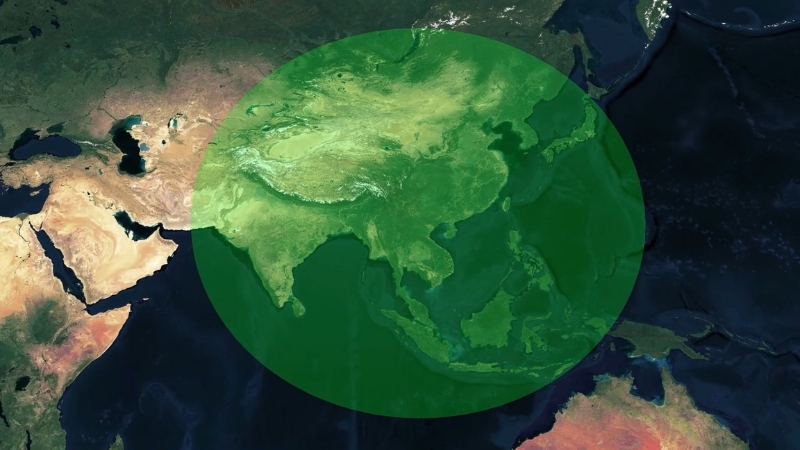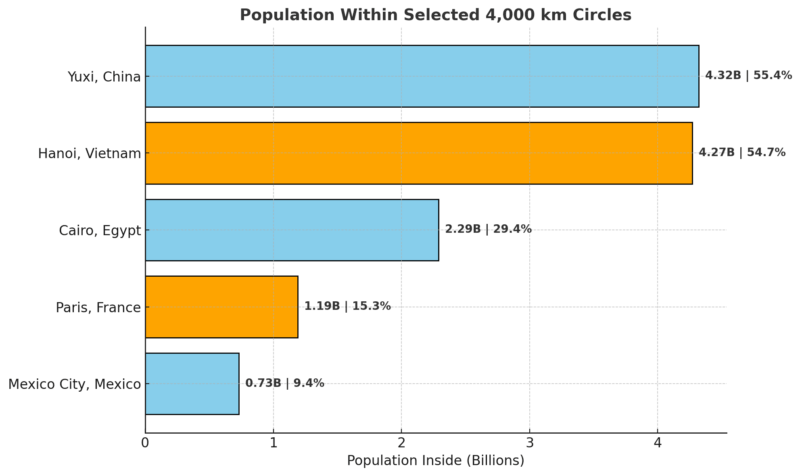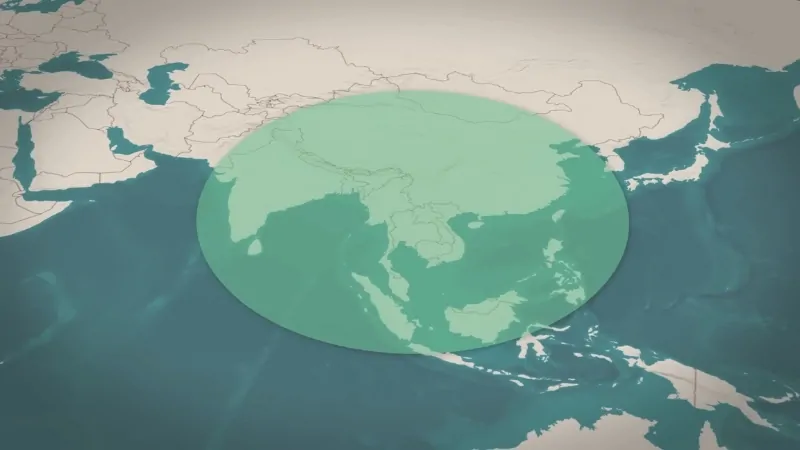If you wanted to capture over half of the world’s population inside a single circle, where would you place it? According to new mapping work, the surprising answer is Yuxi, China.
Within a 4,000 km radius of this mid-sized city in Yunnan province, 4.32 billion people live – over 55% of the global population as of 2020.
This geographical oddity is known as The Yuxi Circle, and it updates an older internet phenomenon: the Valeriepieris circle. Originally posted on Reddit in 2013, the Valeriepieris circle suggested that “more people live inside this circle than outside of it.”
However, it was based on older data and a 2D map projection. Geographer Alasdair Rae revisited the idea with updated datasets and thousands of test circles, ultimately finding Yuxi as the most population-dense epicenter.
How the Yuxi Circle Was Calculated

- Data used: WorldPop estimates from 2020, when the global population stood at 7.8 billion.
- Method: Rae calculated 1,500 circles, each 4,000 km in radius, centered on cities across the globe.
- Results: 148 of those circles contained 4 billion or more people.
Among them, Yuxi came out on top. The circle captures not only China’s eastern megacities but also densely populated regions in India, Bangladesh, Vietnam, Myanmar, and beyond.
Population Within Selected 4,000 km Circles

Why Yuxi?
Yuxi itself is a city of just under 2.5 million people, but its central location relative to Asia’s vast population clusters makes it the ideal hub. The circle includes:
Even though the circle also covers sparsely populated regions like the Gobi Desert, Mongolia, Siberia, and Tibet, the sheer density of South and East Asia dominates.
Other Notable Circles
The “Tightest” Population Cluster
Economist Danny Quah of the London School of Economics went further in 2015, searching for the smallest possible circle with more people inside than outside. He found it with a radius of just 3,300 km, centered near Mong Khet, Myanmar.
Looking Ahead
With shifting demographics, urbanization, and migration, the world’s population clusters are always evolving. For now, the Yuxi Circle remains the clearest way to illustrate just how concentrated humanity is in Asia.
Destinations Where Tourists Outnumber Locals

Tourism Pressure by the Numbers
Tourism can be an economic lifeline – but in some countries, visitors dramatically outnumber residents. According to UN Tourism data (2025), microstates and island territories top the global rankings when measured by tourists per resident.
The extreme case is Andorra, which receives over 52 tourists annually for every local resident. Macao follows with 24 tourists per resident, while several Caribbean and Pacific islands also report double-digit ratios.
Tourist Arrivals vs Resident Populations
Country/Territory
Tourist Arrivals (millions)
Population (thousands)
Tourists per Resident
Andorra
4.17
80
52.1
Macao SAR
16.4
680
24.1
Turks & Caicos
0.73
40
18.3
Aruba
1.42
110
12.9
British Virgin Islands
0.31
30
10.3
Cook Islands
0.17
20
8.5
Malta
3.56
520
6.9
Cayman Islands
0.44
70
6.3
Northern Mariana Islands
0.23
50
4.6
Bahamas
1.87
410
4.6
Guam
0.74
170
4.4
Albania
11.29
2800
4.0
Why Microstates Dominate
Countries with small populations and strong tourism appeal rank highest:
Larger Nations Under Pressure
Not all entries are tiny. Albania, with 11.29 million annual tourists and a population of 2.8 million, averages 4 tourists per resident – a sign of the country’s growing appeal as a Mediterranean destination.
Even Austria and Greece exceed 3 tourists per resident, reflecting their heavy reliance on tourism.
Risks of Tourism Dependence
While these visitor inflows bring money, they also create challenges:
Key Takeaway
@atty.regaloliva 𝐓𝐇𝐄 𝐂𝐈𝐑𝐂𝐋𝐄 𝐖𝐇𝐄𝐑𝐄 𝐇𝐀𝐋𝐅 𝐓𝐇𝐄 𝐖𝐎𝐑𝐋𝐃 𝐋𝐈𝐕𝐄𝐒 #RegalFacts #YuxiCircle #Asia #fyp ♬ original sound – Atty. Regal Mendoza Oliva
The data highlights an imbalance: small states and islands face the greatest tourism intensity, often welcoming many times more visitors than locals.
This creates both prosperity and vulnerability – an issue that is increasingly central to discussions of sustainable tourism.
Related Posts:
- The World’s Largest City You’ve Never Heard Of - Why…
- 26 Most Dangerous Cities in the World 2025 - Where…
- What Is the Lowest Currency in The World 2025?…
- Cancer Deaths Could Nearly Double by 2050 If the…
- What Is The Average IQ in the World - Look At the Stats
- World Population Grows by Over 71 Million in 2024,…








